英语语法讲解讲解加练习
Unit1 --2语法讲解及练习 人教版英语八年级上册

八年级上册unit1语法知识讲堂一般过去时的疑问句1.一般过去时的一般疑问句结构:Did+主语+动词原形+其他?肯定回答:Yes,主语+did.否定回答:No,主语+didn't.【例句】——Did Jim go home yesterday?吉姆昨天回家了吗?——Yes, he did. /No, he didn't.是的,他回了。
/不,他没有回。
2.一般过去时的特殊疑问句结构:特殊疑问词( what,how,where等)+一般疑问句?【例句】What did your mother buy last Sunday?上周日,你的妈妈买什么了?复合不定代词复合不定代词是指由some, any, no, every加one, body, thing等所组成的不定代词,如something(某事/物),anyone(任何人),nothing(没有什么)等。
1. something, someone, somebody的用法something, someone, somebody 通常用于肯定句中,someone与somebody可互换。
【例句】He found something strange.他发现了一些奇怪的事情。
【例句】Look, someone/ somebody is waiting for you.看,有人在等你。
[注意]在表示请求邀请等委婉语气的疑问句,或希望得到对方肯定回答的疑问句中,也可以用something ,someone,somebody。
【例句】Would you like something to eat?你想要一些吃的东西吗?2. anything, anyone, anybody 的用法anything, anyone, anybody多用于否定句或疑问句中。
【例句】I didn't meet anybody on the island.在岛上,我没遇见任何人。
初中英语语法名词用法讲解及专项练习
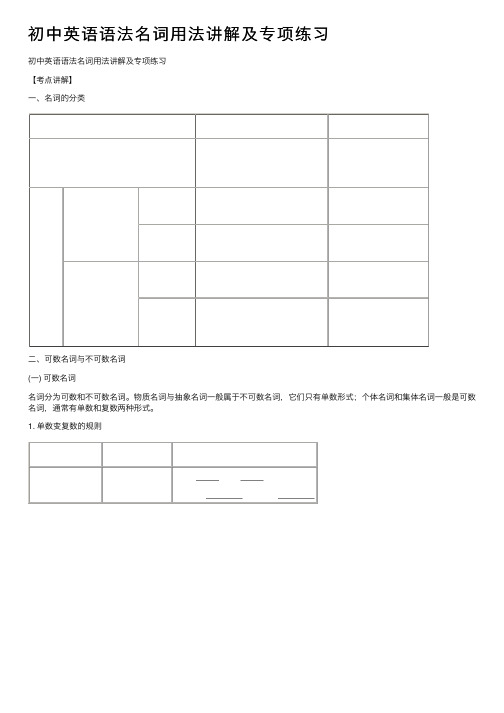
初中英语语法名词⽤法讲解及专项练习初中英语语法名词⽤法讲解及专项练习【考点讲解】⼀、名词的分类⼆、可数名词与不可数名词(⼀) 可数名词名词分为可数和不可数名词。
物质名词与抽象名词⼀般属于不可数名词,它们只有单数形式;个体名词和集体名词⼀般是可数名词,通常有单数和复数两种形式。
1. 单数变复数的规则【注】①常见的以o 结尾要加es 的有如下⼏个:hero, tomato, potato ,可记为“英雄爱吃西红柿和⼟⾖”。
剩余以o 为结尾的加s :如photo, zoo, piano等②以f 或fe 结尾变f 或fe 为v+es 的词有如下:⼩偷的妻⼦⽤⼑把狼劈成两半,⼀半放在书架上,⼀半放在树叶上2. 不规则复数形式(1) 元⾳或词尾发⽣变化:child- , man- , woman-_________, foot- , tooth- , mouse-policeman -___________, Frenchman-_________Englishman-(2) 单复数形式相同: (3) 形式为复数,意思为复数:people ,police(4) 形式为复数,意思为单数:news, maths, physics(5) 只能⽤复数形式:trousers, shoes, glasses ……【注】○1man,woman作定语修饰别的名词时,要把man,woman和其他部分都变成复数,如man teacher –,woman doctor –_____________;○2但是其他合成名词,只需把其中⼼词变成复数形式。
如:shoe factory- , banana tree-3. “某国⼈”的复数形式“中⽇不变英法变,其余s加后边”(⼆)不可数名词不可数名词包括物质名词和抽象名词,⼀般没有复数形式1. 物质名词有water, rice, tea, milk, chicken(鸡⾁), fish(鱼⾁), food, fruit, beef, orange(橙汁), sugar, salt, paper(纸), porridge, bread, sand, juice,chalk等;抽象名词有news, music, time(时间), information等;2. 在英语中,不可数名词如果要表⽰“量”的概念,可以⽤以下两种⽅法:(1) ⽤much, a little, a lot of/lots of, some, any等表⽰多少,例如:a lot of money / some milk / any water / much snow(2) ⽤“a piece / glass / cup / bottle / bag of+不可数名词”或“数词pieces / glasses / cups / bottles / bags of+不可数名词”这类定语,例如:a piece of paper ( wood / bread) →a bottle of orange →a glass of wate r →a cup of tea →a bag of rice →3. 不可数名词不能与数词或不定冠词a/an连⽤;4. 注意有些名词既可作可数名词,也可作不可数名词,此时中⽂意思有区别。
(完整版)高中英语语法讲解与练习
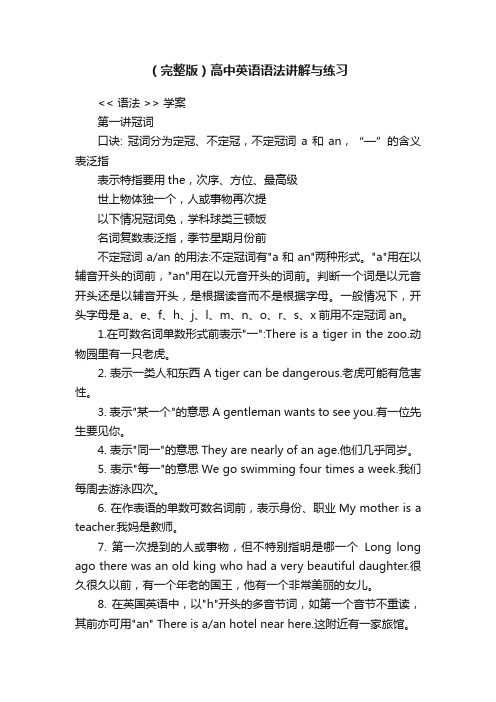
(完整版)高中英语语法讲解与练习<< 语法 >> 学案第一讲冠词口诀: 冠词分为定冠、不定冠,不定冠词a和an,“—”的含义表泛指表示特指要用the,次序、方位、最高级世上物体独一个,人或事物再次提以下情况冠词免,学科球类三顿饭名词复数表泛指,季节星期月份前不定冠词a/an的用法:不定冠词有"a和an"两种形式。
"a"用在以辅音开头的词前,"an"用在以元音开头的词前。
判断一个词是以元音开头还是以辅音开头,是根据读音而不是根据字母。
一般情况下,开头字母是a、e、f、h、j、l、m、n、o、r、s、x前用不定冠词an。
1.在可数名词单数形式前表示"一":There is a tiger in the zoo.动物园里有一只老虎。
2. 表示一类人和东西 A tiger can be dangerous.老虎可能有危害性。
3. 表示"某一个"的意思A gentleman wants to see you.有一位先生要见你。
4. 表示"同一"的意思They are nearly of an age.他们几乎同岁。
5. 表示"每一"的意思We go swimming four times a week.我们每周去游泳四次。
6. 在作表语的单数可数名词前,表示身份、职业My mother is a teacher.我妈是教师。
7. 第一次提到的人或事物,但不特别指明是哪一个Long long ago there was an old king who had a very beautiful daughter.很久很久以前,有一个年老的国王,他有一个非常美丽的女儿。
8. 在英国英语中,以"h"开头的多音节词,如第一个音节不重读,其前亦可用"an" There is a/an hotel near here.这附近有一家旅馆。
高中英语语法专项练习题及讲解
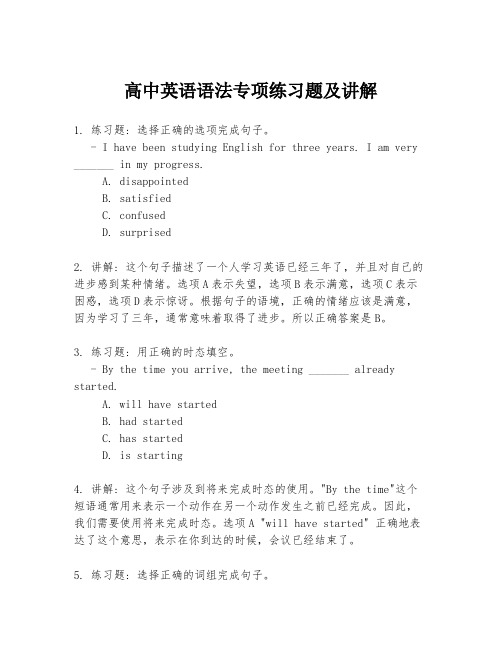
高中英语语法专项练习题及讲解1. 练习题: 选择正确的选项完成句子。
- I have been studying English for three years. I am very _______ in my progress.A. disappointedB. satisfiedC. confusedD. surprised2. 讲解: 这个句子描述了一个人学习英语已经三年了,并且对自己的进步感到某种情绪。
选项A表示失望,选项B表示满意,选项C表示困惑,选项D表示惊讶。
根据句子的语境,正确的情绪应该是满意,因为学习了三年,通常意味着取得了进步。
所以正确答案是B。
3. 练习题: 用正确的时态填空。
- By the time you arrive, the meeting _______ already started.A. will have startedB. had startedC. has startedD. is starting4. 讲解: 这个句子涉及到将来完成时态的使用。
"By the time"这个短语通常用来表示一个动作在另一个动作发生之前已经完成。
因此,我们需要使用将来完成时态。
选项A "will have started" 正确地表达了这个意思,表示在你到达的时候,会议已经结束了。
5. 练习题: 选择正确的词组完成句子。
- The teacher _______ the students to hand in their homework on time.A. expects ofB. expects fromC. expects toD. expects6. 讲解: 这个句子需要一个词组来表达老师对学生的期望。
选项A和B都包含了"expects",但是"of"和"from"在这里都不适用。
高考英语语法名词专题讲解练习含答案
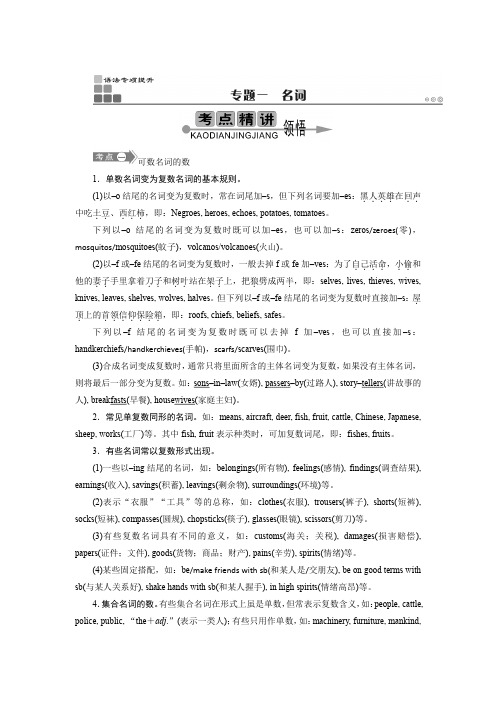
可数名词的数1.单数名词变为复数名词的基本规则。
(1)以–o 结尾的名词变为复数时,常在词尾加–s ,但下列名词要加–es :黑人英雄....在回声..中吃土豆..、西红柿...,即:Negroes, heroes, echoes, potatoes, tomatoes 。
下列以–o 结尾的名词变为复数时既可以加–es ,也可以加–s :zeros /zeroes(零),mosquitos/mosquitoes(蚊子),volcanos/volcanoes(火山)。
(2)以–f 或–fe 结尾的名词变为复数时,一般去掉f 或fe 加–ves :为了自己活命....,小偷..和他的妻子..手里拿着刀子..和树叶..站在架子..上,把狼.劈成两半.,即:selves, lives, thieves, wives, knives, leaves, shelves, wolves, halves 。
但下列以–f 或–fe 结尾的名词变为复数时直接加–s :屋.顶.上的首领信仰保险箱.......,即:roofs, chiefs, beliefs, safes 。
下列以–f 结尾的名词变为复数时既可以去掉f 加–ves ,也可以直接加–s :handkerchiefs /handkerchieves(手帕),scarfs/scarves(围巾)。
(3)合成名词变成复数时,通常只将里面所含的主体名词变为复数,如果没有主体名词,则将最后一部分变为复数。
如:sons–in–law(女婿), passers–by(过路人), story–tellers(讲故事的人), breakfasts(早餐), housewives(家庭主妇)。
2.常见单复数同形的名词。
如:means, aircraft, deer, fish, fruit, cattle, Chinese, Japanese, sheep, works(工厂)等。
小学英语语法讲解及习题

语法第一讲重点:缩写形式;an & a & X 的用法;一般疑问句;否定句;肯定回答/否定回答;单数改为复数Ⅰ. 缩写形式I’m=I am he’s=he is she’s=she is they’re=they areyou’re=you are there’s=there is they’re=they are can’t=can notdon’t=do not doe sn’t=does not isn’t=is not aren’t=are notlet’s=let us won’t=will not I’ll=I will wasn’t=was not总结:通常情况下,'m即am,'s即is(但let’s=let us),'re即are ,n't即not (但can’t=can not)Ⅱ.an & a & X的用法a用在辅音音素前,包括以前元音[j]、[w]开首的词前,读作[E],强调时读作[ei]。
注意,这里讲的辅音音素指的是发音,不是指辅音字母。
an用在元音音素前(不是元音字母),读作[En],强调时读作[An]。
例:a hotel [hEu5tel]一家旅馆a knife [naif] 一把小刀a useful tool [5ju:sful] 一件有用的工具a university [7ju:ni5vE:siti] 一所大学a European country [7juErE5pi(:)En] 一个欧洲国家a one-eyed man ['wQn5aid] 一个一目失明的人an hour [5auE] 一小时an ant [Ant] 一只蚂蚁an honour [5CnE] 一种荣誉an honest boy [5Cnist] 一个诚实的男孩an umbrella [Qm5brelE] 一把伞an onion [5QnjEn] 一个洋葱an eye [ai] 一只眼睛an ear [iE] 一只耳朵an English book [5iN^liF] 一本英语书an egg [e^] 一只鸡蛋an apple [5Apl] 一个苹果an island [5ailEnd] 一座岛an uncle [5QNkl] 一位叔叔an old man [Euld] 一位老人an elephant [5elifEnt] 一头大象a D [di:] 一个D (B、C、G、J、K、P、Q、T、U、V、W、Y、Z前也用a)an F [ef] 一个F(A、E、H、I、L、M、N、O、R、S、X前也用an)Ⅲ.一般疑问句与否定句Be动词的用法口诀:我用am,你用are,is连着他,她,它;单数名词用is,复数名词全用are。
高中英语语法:主谓一致-讲解与练习
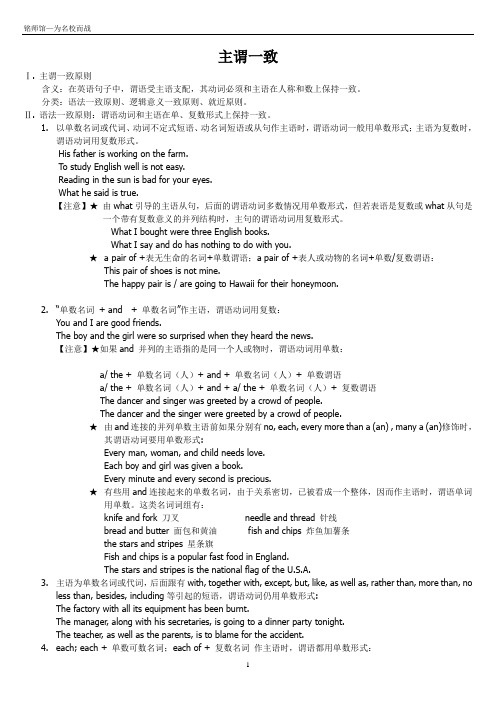
主谓一致Ⅰ. 主谓一致原则含义:在英语句子中,谓语受主语支配,其动词必须和主语在人称和数上保持一致。
分类:语法一致原则、逻辑意义一致原则、就近原则。
Ⅱ. 语法一致原则:谓语动词和主语在单、复数形式上保持一致。
1.以单数名词或代词、动词不定式短语、动名词短语或从句作主语时,谓语动词一般用单数形式;主语为复数时,谓语动词用复数形式。
His father is working on the farm.To study English well is not easy.Reading in the sun is bad for your eyes.What he said is true.【注意】★由what引导的主语从句,后面的谓语动词多数情况用单数形式,但若表语是复数或what从句是一个带有复数意义的并列结构时,主句的谓语动词用复数形式。
What I bought were three English books.What I say and do has nothing to do with you.★ a pair of +表无生命的名词+单数谓语;a pair of +表人或动物的名词+单数/复数谓语:This pair of shoes is not mine.The happy pair is / are going to Hawaii for their honeymoon.2.―单数名词+ and + 单数名词‖作主语,谓语动词用复数:You and I are good friends.The boy and the girl were so surprised when they heard the news.【注意】★如果and 并列的主语指的是同一个人或物时,谓语动词用单数:a/ the + 单数名词(人)+ and + 单数名词(人)+ 单数谓语a/ the + 单数名词(人)+ and + a/ the + 单数名词(人)+ 复数谓语The dancer and singer was greeted by a crowd of people.The dancer and the singer were greeted by a crowd of people.★由and连接的并列单数主语前如果分别有no, each, every more than a (an) , many a (an)修饰时,其谓语动词要用单数形式:Every man, woman, and child needs love.Each boy and girl was given a book.Every minute and every second is precious.★有些用and连接起来的单数名词,由于关系密切,已被看成一个整体,因而作主语时,谓语单词用单数。
八年级英语语法练习题解析与讲解
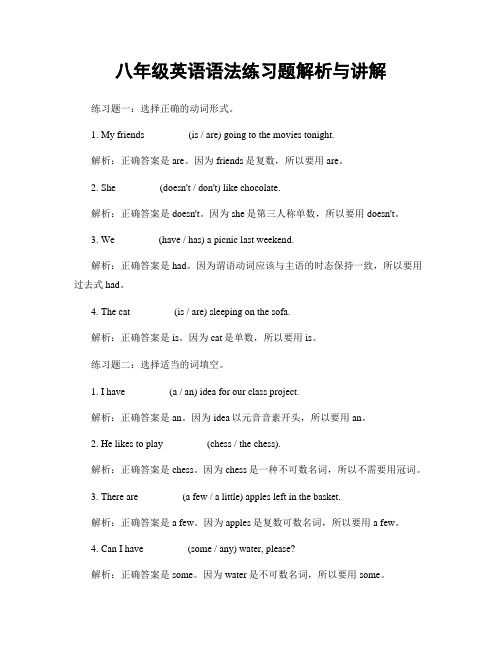
八年级英语语法练习题解析与讲解练习题一:选择正确的动词形式。
1. My friends ________ (is / are) going to the movies tonight.解析:正确答案是are。
因为friends是复数,所以要用are。
2. She ________ (doesn't / don't) like chocolate.解析:正确答案是doesn't。
因为she是第三人称单数,所以要用doesn't。
3. We ________ (have / has) a picnic last weekend.解析:正确答案是had。
因为谓语动词应该与主语的时态保持一致,所以要用过去式had。
4. The cat ________ (is / are) sleeping on the sofa.解析:正确答案是is。
因为cat是单数,所以要用is。
练习题二:选择适当的词填空。
1. I have ________ (a / an) idea for our class project.解析:正确答案是an。
因为idea以元音音素开头,所以要用an。
2. He likes to play ________ (chess / the chess).解析:正确答案是chess。
因为chess是一种不可数名词,所以不需要用冠词。
3. There are ________ (a few / a little) apples left in the basket.解析:正确答案是a few。
因为apples是复数可数名词,所以要用a few。
4. Can I have ________ (some / any) water, please?解析:正确答案是some。
因为water是不可数名词,所以要用some。
练习题三:选择合适的时态填空。
1. They ________ (will arrive / arrived) at the airport tomorrow.解析:正确答案是will arrive。
初中英语语法讲解-15个专题汇总(习题和答案)word版
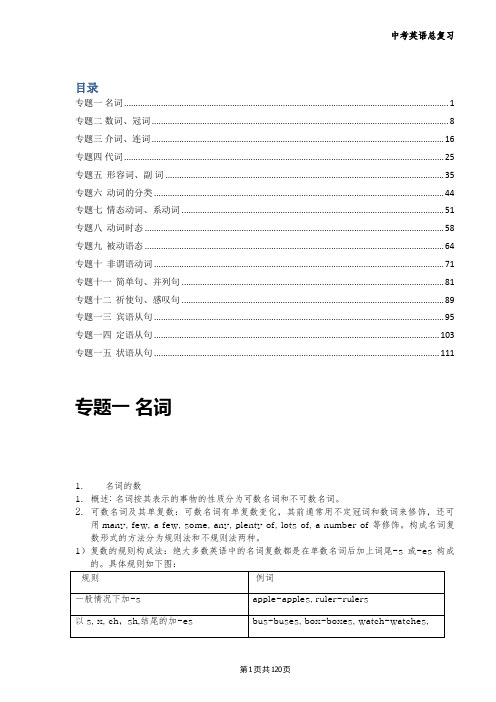
目录专题一名词 (1)专题二数词、冠词 (8)专题三介词、连词 (16)专题四代词 (25)专题五形容词、副词 (35)专题六动词的分类 (44)专题七情态动词、系动词 (51)专题八动词时态 (58)专题九被动语态 (64)专题十非谓语动词 (71)专题十一简单句、并列句 (81)专题十二祈使句、感叹句 (89)专题一三宾语从句 (95)专题一四定语从句 (103)专题一五状语从句 (111)专题一名词1.名词的数1.概述: 名词按其表示的事物的性质分为可数名词和不可数名词。
2.可数名词及其单复数:可数名词有单复数变化,其前通常用不定冠词和数词来修饰,还可用many, few, a few, some, any, plenty of, lots of, a number of 等修饰。
构成名词复数形式的方法分为规则法和不规则法两种。
1)复数的规则构成法:绝大多数英语中的名词复数都是在单数名词后加上词尾-s或-es构成的。
具体规则如下图:a.单复同形的:Chinese-Chinese, Japanese-Japanese, deer-deer, sheep-sheep, fish-fish(表示鱼的数量)b. 熟记下列词的复数变化:man-men, woman-women, policeman-policemen, foot-feet, tooth-teeth, mouse-mice, child-childrenc. 以man, woman做定语构成的复合名词,变复数时要全变:a man teacher-two men teachers; 其他情况一般只变主体名词而作定语的名词不变:a girl student-two girl students3. 不可数名词:不可数名词没有单复数。
如:water, meat, air等。
在表示数量时,通常用以下方法。
1)用some, much, a little, little, a lot of, lots of, plenty of 等表示多少。
(完整版)初中英语语法介词用法讲解与练习
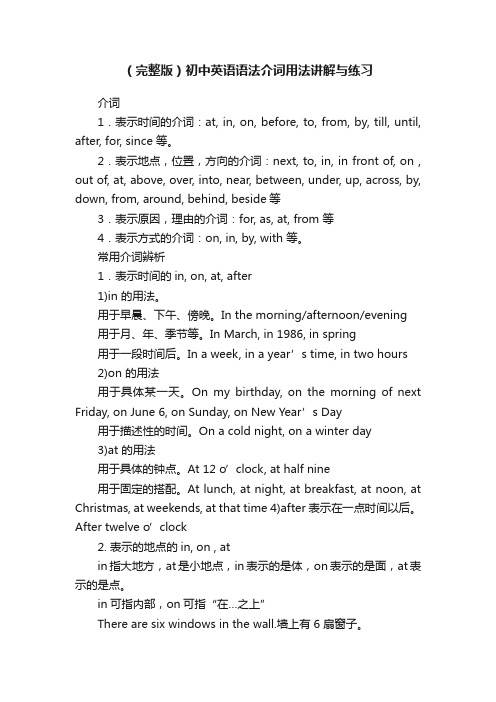
(完整版)初中英语语法介词用法讲解与练习介词1.表示时间的介词:at, in, on, before, to, from, by, till, until, after, for, since 等。
2.表示地点,位置,方向的介词:next, to, in, in front of, on , out of, at, above, over, into, near, between, under, up, across, by, down, from, around, behind, beside等3.表示原因,理由的介词:for, as, at, from 等4.表示方式的介词:on, in, by, with 等。
常用介词辨析1.表示时间的in, on, at, after1)in 的用法。
用于早晨、下午、傍晚。
In the morning/afternoon/evening用于月、年、季节等。
In March, in 1986, in spring用于一段时间后。
In a week, in a year’s time, in two hours2)on 的用法用于具体某一天。
On my birthday, on the morning of next Friday, on June 6, on Sunday, on New Year’s Day用于描述性的时间。
On a cold night, on a winter day3)at 的用法用于具体的钟点。
At 12 o’clock, at half nine用于固定的搭配。
At lunch, at night, at breakfast, at noon, at Christmas, at weekends, at that time 4)after 表示在一点时间以后。
After twelve o’clock2. 表示的地点的in, on , atin指大地方,at是小地点,in表示的是体,on表示的是面,at表示的是点。
初中英语语法同位语从句讲解专项练习及答案
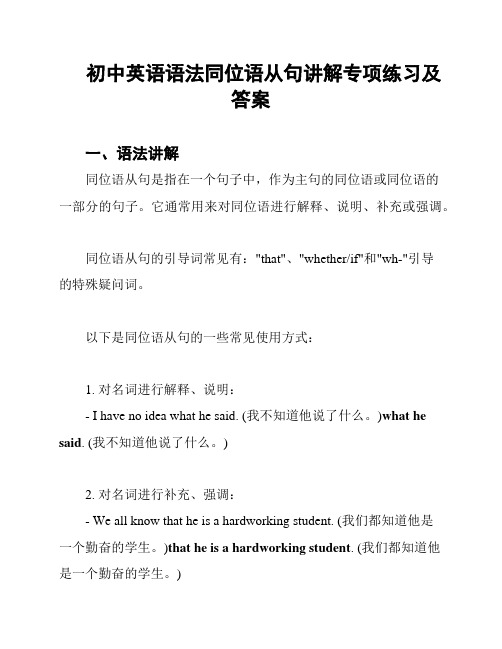
初中英语语法同位语从句讲解专项练习及答案一、语法讲解同位语从句是指在一个句子中,作为主句的同位语或同位语的一部分的句子。
它通常用来对同位语进行解释、说明、补充或强调。
同位语从句的引导词常见有:"that"、"whether/if"和"wh-"引导的特殊疑问词。
以下是同位语从句的一些常见使用方式:1. 对名词进行解释、说明:- I have no idea what he said. (我不知道他说了什么。
)what he said. (我不知道他说了什么。
)2. 对名词进行补充、强调:- We all know that he is a hardworking student. (我们都知道他是一个勤奋的学生。
)that he is a hardworking student. (我们都知道他是一个勤奋的学生。
)- The fact remains that she is guilty. (事实仍然是她有罪。
)that she is guilty. (事实仍然是她有罪。
)3. 对名词进行特殊疑问:- Could you tell me where he lives? (你能告诉我他住在哪里吗?)where he lives? (你能告诉我他住在哪里吗?)同位语从句用来修饰名词,起到进一步解释、补充或强调的作用。
二、练题及答案请根据以下句子中的同位语,填写合适的同位语从句。
1. We are all aware of the fact ____ he is a talented musician.the fact ____ he is a talented musician.- that2. The question whether ____ to attend the party or not is up to you.whether ____ to attend the party or not is up to you.- whether/if- why4. His only hope is that ____ he can pass the exam.that ____ he can pass the exam.- that5. We have no idea what ____ happened to him after the accident.what ____ happened to him after the accident.- what6. I doubt whether ____ she will be able to finish the project on time.whether ____ she will be able to finish the project on time.- whether/if7. I am curious about the place ____ they went for vacation.the place ____ they went for vacation.- where8. It is important to know what ____ happened during the meeting.what ____ happened during the meeting.- what9. His dream is that ____ he can travel around the world.that ____ he can travel around the world.- that10. The fact remains that ____ she is innocent.that ____ she is innocent.- that三、练答案1. We are all aware of the fact that he is a talented musician.the fact that he is a talented musician.2. The question whether to attend the party or not is up toyou.whether to attend the party or not is up to you.4. His only hope is that he can pass the exam.that he can pass the exam.5. We have no idea what happened to him after the accident.what happened to him after the accident.6. I doubt whether she will be able to finish the project ontime.whether she will be able to finish the project on time.7. I am curious about the place where they went for vacation.the place where they went for vacation.8. It is important to know what happened during the meeting.what happened during the meeting.9. His dream is that he can travel around the world.that he can travel around the world.10. The fact remains that she is innocent.that she is innocent.以上是初中英语语法同位语从句的讲解及练习题及答案。
高中英语语法讲解与练习:动名词
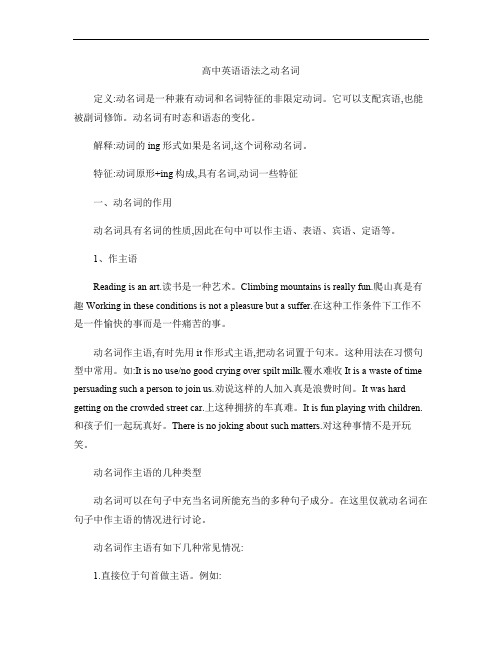
高中英语语法之动名词定义:动名词是一种兼有动词和名词特征的非限定动词。
它可以支配宾语,也能被副词修饰。
动名词有时态和语态的变化。
解释:动词的ing形式如果是名词,这个词称动名词。
特征:动词原形+ing构成,具有名词,动词一些特征一、动名词的作用动名词具有名词的性质,因此在句中可以作主语、表语、宾语、定语等。
1、作主语Reading is an art.读书是一种艺术。
Climbing mountains is really fun.爬山真是有趣Working in these conditions is not a pleasure but a suffer.在这种工作条件下工作不是一件愉快的事而是一件痛苦的事。
动名词作主语,有时先用it作形式主语,把动名词置于句末。
这种用法在习惯句型中常用。
如:It is no use/no good crying over spilt milk.覆水难收It is a waste of time persuading such a person to join us.劝说这样的人加入真是浪费时间。
It was hard getting on the crowded street car.上这种拥挤的车真难。
It is fun playing with children.和孩子们一起玩真好。
There is no joking about such matters.对这种事情不是开玩笑。
动名词作主语的几种类型动名词可以在句子中充当名词所能充当的多种句子成分。
在这里仅就动名词在句子中作主语的情况进行讨论。
动名词作主语有如下几种常见情况:1.直接位于句首做主语。
例如:Swimming is a good sport in summer.2.用it作形式主语,把动名词(真实主语置于句尾作后置主语。
动名词做主语时,不太常用it作先行主语,多见于某些形容词及名词之后。
例如:It is no use telling him not to worry.常见的能用于这种结构的形容词还有:better,wonderful,enjoyable,interesting,foolish,difficult,useless,senseless,worthwhile,等。
小学英语语法--冠词语法精细讲解及对应练习题

A.a
B.an
C. the
D./
5 . To n y h a s _ ___ egg a n d s o m e ve g e t a b le s f o r b r e a kfast.
A.a
B.an
C.some
D.any
冠词习题练一练
6. I have____French stamp. The stamp is beautiful.
at school 上学 at table 在吃饭 in bed (睡、病、躺)在床上 in hospital 住院 by sea 乘船 in front of 在……前面(外部) on earth 究竟
冠词习题练一练
一、填写适当的冠词 _____ball _____book _____apple _____story _____Earth ______egg _____chair _____sun _____pear _____onion 二、用适当的冠词填空 1.___sun is very hot. 2. Can I have ___ apple? 3. Do you want to eat ___ egg? 4. I want to buy ___ new car. 5. Mommy likes to read ___ story. 6. I have ___ blue ball. 7. He broke ___ chair. 8. She reads ___ book in class. 9. I have ___ apple and ___ pear for lunch.
冠词习题练一练 三.圈出正确的冠词 1. Sue had to hurry to catch the / an bus. 2. Clive and Julian played guitar in a / an band. 3. Petey buried an / a bone in Nana's backyard. 4. My school won the / an first place prize for selling candles! 5. I want to ride my bike to the / a friend's house. 6. The / An new computer we bought has iTunes on it. 7. My sneakers have a / an orange stripe on the side. 8. Legos are fun to play with the / a friend or two. 9. We watched a TV show being filmed in a / the town. 10. I watched as mom put the Cream-of-Wheat into a / an pot.
初中英语语法大全全套讲解及练习

初中英语语法大全一、词类、句子成分和构词法:1、词类:英语词类分十种:名词、形容词、代词、数词、冠词动词、副词、介词、连词、感叹词。
1、名词(n.):表人、事物、地点或抽象概念的名称。
如:boy, morning, bag, ball, class, orange.2、代词(pron.):主要用来代替名词。
如:who, she, you, it .3、形容词(adj..):表示人或事物的性质或特征。
如:good, right, white, orange .4、数词(num.):表示数目或事物的顺序。
如:one, two, three, first, second, third, fourth.5、动词(v.):表示动作或状态。
如:am, is,are,have,see .6、副词(adv.):修饰动词、形容词或其他副词,说明时间、地点、程度等。
如:now, very, here, often,quietly, slowly.7、冠词(art..):用在名词前,帮助说明名词。
如:a, an, the.8、介词(prep.):表示它后面名词或代词与其他句子成分关系。
如in, on, from, above, behind.9、连词(conj.):用来连接词、短语或句子。
如and, but, before .10、感叹词(interj..)表示喜、怒、哀、乐等感情。
如:oh, well, hi, hello.2、句子成分:英语句子成分分为七种:主、谓、宾、定、状、表、宾补。
1、主语是句子所要说的人或事物,回答是“谁”或者“什么”。
通常用名词或代词担任。
如:I’m MissGreen.(我是格林小姐)2、谓语动词说明主语的动作或状态,回答“做(什么)”。
主要由动词担任。
如:Jack cleans the room everyday. (杰克每天打扫房间)3、表语在系动词之后,说明主语的身份或特征,回答是“什么”或者“怎么样”。
(完整版)初中英语语法宾语从句讲解专项练习及答案
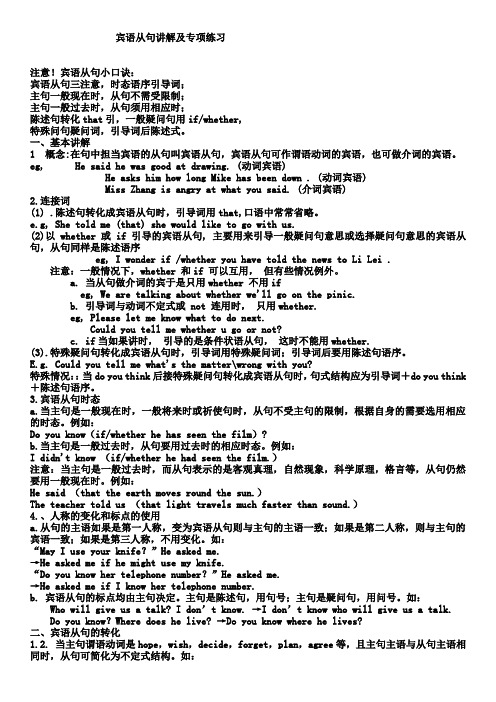
宾语从句讲解及专项练习注意!宾语从句小口诀:宾语从句三注意,时态语序引导词;主句一般现在时,从句不需受限制;主句一般过去时,从句须用相应时;陈述句转化that引,一般疑问句用if/whether,特殊问句疑问词,引导词后陈述式。
一、基本讲解1 概念:在句中担当宾语的从句叫宾语从句,宾语从句可作谓语动词的宾语,也可做介词的宾语。
eg, He said he was good at drawing. (动词宾语)He asks him how long Mike has been down . (动词宾语)Miss Zhang is angry at what you said. (介词宾语)2.连接词(1) .陈述句转化成宾语从句时,引导词用that,口语中常常省略。
e.g, She told me (that) she would like to go with us.(2)以 whether 或 if 引导的宾语从句, 主要用来引导一般疑问句意思或选择疑问句意思的宾语从句,从句同样是陈述语序eg, I wonder if /whether you have told the news to Li Lei .注意:一般情况下,whether 和if 可以互用,但有些情况例外。
a. 当从句做介词的宾于是只用whether 不用ifeg, We are talking about whether we'll go on the pinic.b. 引导词与动词不定式或 not 连用时,只用whether.eg, Please let me know what to do next.Could you tell me whether u go or not?c. if当如果讲时,引导的是条件状语从句,这时不能用whether.(3).特殊疑问句转化成宾语从句时,引导词用特殊疑问词;引导词后要用陈述句语序。
英语语法:冠词讲解及练习题(附答案)
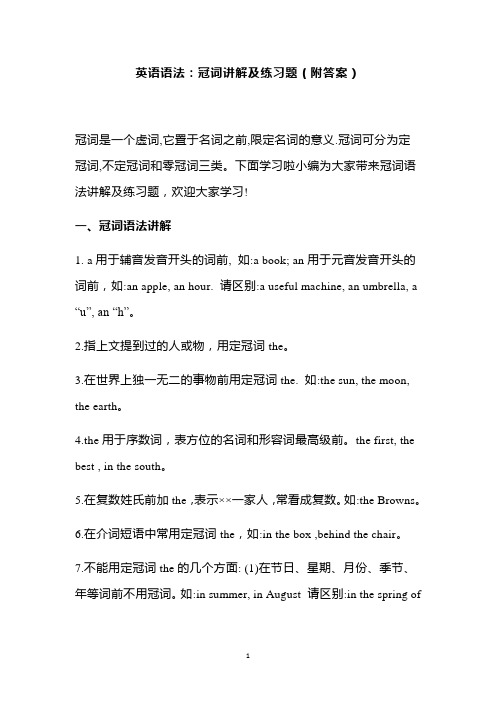
英语语法:冠词讲解及练习题(附答案)冠词是一个虚词,它置于名词之前,限定名词的意义.冠词可分为定冠词,不定冠词和零冠词三类。
下面学习啦小编为大家带来冠词语法讲解及练习题,欢迎大家学习!一、冠词语法讲解1. a用于辅音发音开头的词前, 如:a book; an用于元音发音开头的词前,如:an apple, an hour. 请区别:a useful machine, an umbrella, a “u”, an “h”。
2.指上文提到过的人或物,用定冠词the。
3.在世界上独一无二的事物前用定冠词the. 如:the sun, the moon, the earth。
4.the用于序数词,表方位的名词和形容词最高级前。
the first, the best , in the south。
5.在复数姓氏前加the,表示××一家人,常看成复数。
如:the Browns。
6.在介词短语中常用定冠词the,如:in the box ,behind the chair。
7.不能用定冠词the的几个方面: (1)在节日、星期、月份、季节、年等词前不用冠词。
如:in summer, in August 请区别:in the spring of1945. (这里表示特指,故加the)(2)一日三餐和球类运动名不用冠词。
如:have breakfast ,play football(3)一些固定词组中,如:go to bed ,go to school, by bus ,at night. 8.在有些词组中,有冠词和无冠词意思不同,请注意区别:in front of 在…前面, in the front of 在…范围内的前部in hospital (生病)住院, in the hospital 在医院里。
二、练习题1. When Linda was a child,her mother always let her have ______ bed.A. the breakfast inB. the breakfast in theC. breakfast inD. breakfast in the2. Beyond ______ stars the astronaut saw nothing but ______ space.A. the,不填B. 不填,theC. 不填,不填D. the,the3. Alexander Graham Bell invented ________ telephone in 1876.A. 不填B. aC. theD. one4. After watching ____ TV,she played _____ violin for an hour.A. 不填,不填B. the,theC. the,不填D. 不填,the5. Many people are still in ____ habit of writing silly things in ____ public places.A. the,theB. 不填,不填C. the,不填D. 不填,the6. Paper money was in ____ use in China when Marco Polo visited the country in ____ thirteenth century.A. the,不填B. the,theC. 不填,theD. 不填,不填7. Have you seen ______ pen? I left it here this morning.Is it ____ black one? I think I saw it somewhere.A. a,theB. the,theC. the, aD. a, a8. She is _____ newcomer to ____ chemistry but she has already made some important discoveries.A. the,theB. the,不填C. a,不填D. a,the9. Many people agree that ___ knowledge of English is a must in ____ international trade today.A. a,不填B. the,anC. the,theD. 不填,the10. ______ usually go to church every Sunday.A. The BrownB. A BrownC. BrownsD. The Browns11. The train is running fifty miles ______.A. an hourB. one hourC. the hourD. a hour12. ___ earth we live on is bigger than___ moon.A. The, aB. The,theC. An, aD. An,the13. —What’s the matter with you ?—I caught ___ bad cold and had to stay in ___bed.A. a,/B. a,theC. a, aD. the,the14. —Do you know ___ lady in blue?—Yes. She is a teacher of a university.A. theB. aC. anD. /15. —Where’s ___ nearest supermarket?—It’s over there,just around the corner.A. aB. anC. theD. /16. The young man will work in ___ school as a maths teacher.A. theB. aC. anD. /17. Most of the representatives think that ______ the meeting was very successful.A. on whole ofB. on a wholeC. on the wholeD. on the whole that18. The investigators found that more should be done for ______ in India.A. those poorB. a poorC. poorD. the poor19. He grabbed me ______ and pulled me onto the bus.A. a armB. an armC. the armD. by the arm20. “How did you pay the workers?”“As a rule,they are paid ______.”A. by an yourB. by the hourC. by a hourD. by hours21. What _____ exciting football match! Our team beat Tom’s team at last.A. aB. anC. theD. /22. In the United States,Father’s Day falls on _____ third Sunday in _____ June.A. the,不填B. the, aC. 不填,theD. a,不填23. I have two dogs. ______ black one is two years old and ______ yellow one is three years old.A. A, aB. The, aC. The,theD. A. the24. ______ new bridge has been built over ______ Huangpu River.A. The, aB. A,/C. A,theD. An,an25. -What colour is ______ orange?-It’s _____ orange.A. an,anB. an,theC. an,/D. /,an参考答案:1. C2. A。
小学英语语法及练习题
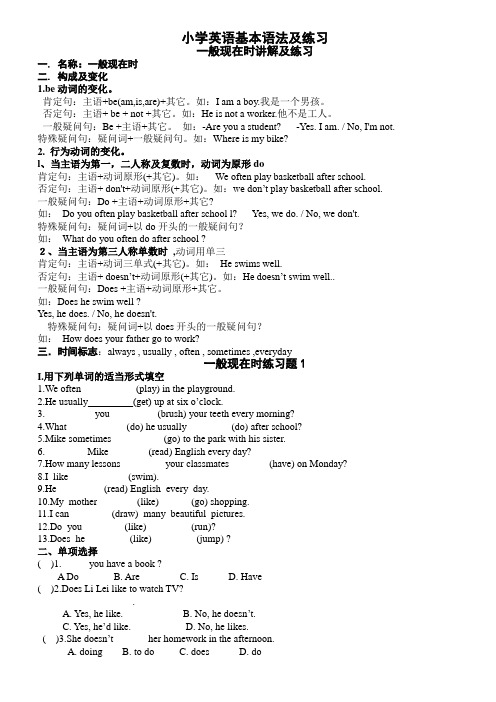
小学英语基本语法及练习一般现在时讲解及练习一. 名称:一般现在时二. 构成及变化1.be动词的变化。
肯定句:主语+be(am,is,are)+其它。
如:I am a boy.我是一个男孩。
否定句:主语+ be + not +其它。
如:He is not a worker.他不是工人。
一般疑问句:Be +主语+其它。
如:-Are you a student? -Yes. I am. / No, I'm not. 特殊疑问句:疑问词+一般疑问句。
如:Where is my bike?2. 行为动词的变化。
l、当主语为第一,二人称及复数时,动词为原形do肯定句:主语+动词原形(+其它)。
如:We often play basketball after school.否定句:主语+ don't+动词原形(+其它)。
如:we don’t play basketball after school.一般疑问句:Do +主语+动词原形+其它?如:Do you often play basketball after school l? Yes, we do. / No, we don't.特殊疑问句:疑问词+以do开头的一般疑问句?如:What do you often do after school ?2、当主语为第三人称单数时,动词用单三肯定句:主语+动词三单式(+其它)。
如:He swims well.否定句:主语+ doesn’t+动词原形(+其它)。
如:He doesn’t swim well..一般疑问句:Does +主语+动词原形+其它。
如:Does he swim well ?Yes, he does. / No, he doesn't.特殊疑问句:疑问词+以does开头的一般疑问句?如:How does your father go to work?三.时间标志:always , usually , often , sometimes ,everyday一般现在时练习题1I.用下列单词的适当形式填空1.We often___________(play) in the playground.2.He usually_________(get) up at six o’clock.3.__________you _________(brush) your teeth every morning?4.What____________(do) he usually_________(do) after school?5.Mike sometimes __________(go) to the park with his sister.6.________ Mike________(read) English every day?7.How many lessons_________your classmates________(have) on Monday?8.I like ___________ (swim).9.He _________(read) English every day.10.My mother________(like) ______(go) shopping.11.I can ________(draw) many beautiful pictures.12.Do you ________(like)_________(run)?13.Does he_________(like)_________(jump) ?二、单项选择( )1._____ you have a book ?A Do B. Are C. Is D. Have( )2.Does Li Lei like to watch TV?______________.A. Yes, he like.B. No, he doesn’t.C. Yes, he’d like.D. No, he likes.( )3.She doesn’t ______ her homework in the afternoon.A. doingB. to doC. doesD. do( )4.How ____ Mr. Smith ______ to England?A. do, goB. is , goC. does, goD. does , goes( )5. _____ she ______ home at six every day?A. Is , leaveB. Does , leaveC. Is , leavesD. Does , left三、按要求完成下列各题1.Tomorrow is Saturday.(变成一般疑问句)_________ ________ Saturday ?2.Does he play basketball every weekend? (肯定回答)Yes, ______ _______.3.She looks like her sister.(变一般疑问句)_____ she ______ like her sister ?4.Peter and Sam look the same.(一般疑问句)______ they _____ the same ?5.Do they always go to the movie (电影院) on Sundays ? (否定回答)No, _______ _______.现在进行时态精讲精练1.名称:现在进行时例:I am reading an English book now. 我现在正在读一本英语书。
初中英语语法:动词时态讲解及练习
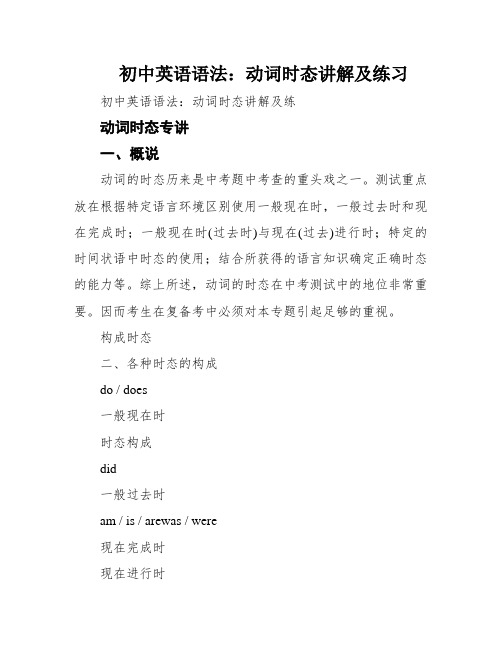
初中英语语法:动词时态讲解及练习初中英语语法:动词时态讲解及练动词时态专讲一、概说动词的时态历来是中考题中考查的重头戏之一。
测试重点放在根据特定语言环境区别使用一般现在时,一般过去时和现在完成时;一般现在时(过去时)与现在(过去)进行时;特定的时间状语中时态的使用;结合所获得的语言知识确定正确时态的能力等。
综上所述,动词的时态在中考测试中的地位非常重要。
因而考生在复备考中必须对本专题引起足够的重视。
构成时态二、各种时态的构成do / does一般现在时时态构成did一般过去时am / is / arewas / were现在完成时现在进行时一般将来时am / is / are + doinghave / has + doneshall / will + do曩昔完成时过去进行时过去将来时was / were + doingwould + dohad + donewas / were going + to doam / is / are going + to do普通目前时三、各种时态的用法1.透露表现经常性或气性的举措,常与透露表现频度的工夫状语连用。
时间状语:every day,every other day,sometimes,often,usually,on Sunday …I leave home for school at 7 _________________ (天天清晨).The Olympic Games are held ____________________ (每四年).What do you ____________ (平日) do when you are free on Sunday?2.用在客观真理,客观存在,科学事实或格言警句中。
The earth _________________ (绕着……转) the sun.Shanghai lies in the east of China.上海__________中国的东方。
2020年高考英语语法讲解及考点练习(倒装句+省略句+强调句+情态动词)
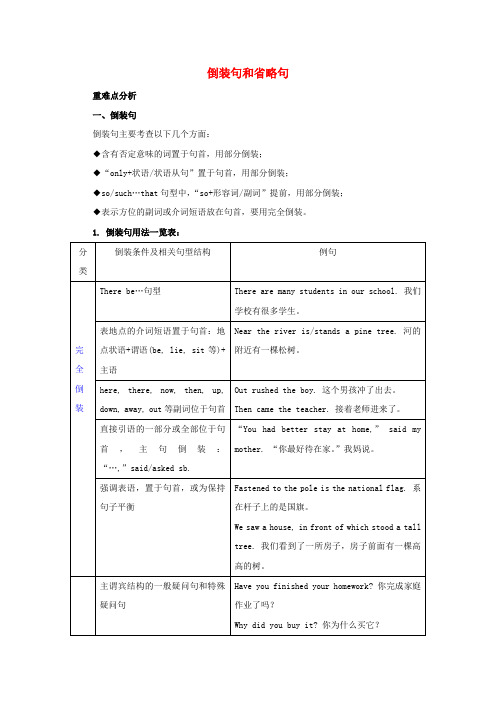
倒装句和省略句重难点分析一、倒装句倒装句主要考查以下几个方面:◆含有否定意味的词置于句首,用部分倒装;◆“only+状语/状语从句”置于句首,用部分倒装;◆so/such…that句型中,“so+形容词/副词”提前,用部分倒装;◆表示方位的副词或介词短语放在句首,要用完全倒装。
1. 倒装句用法一览表:2. 特别提示(1) there be结构的倒装句型中,除了be动词之外,there后还可接lie, live, seemto be等。
如:There lived an old man in the village long long ago. 很久很久以前,村子里住着一位老人。
(2) here, there, now, then, up, down, away, out等副词位于句首,主语为代词时不到装。
如:Away it flew. 它飞走了。
(3) 直接引语的一部分或全部位于句首,主句倒装,主句倒装,但是主语为代词时不倒装。
如:“You have to finish it tonight,” she said. “今晚你必须完成它,”她说。
(4) so位于句首不倒装的情况:① 主语与前句相同,表赞同,译为“确实如此”。
如:— Mike studies hard. 迈克学习很刻苦。
— So he does. 确实是。
② 表示前句内容也适用于另外的人或事,前句如果列举了两种事实以上,用“so it is/was with sb./sth.”回答。
如:— Tom is kind and often helps those in trouble. 汤姆很友好,经常帮助处于困境中的人。
— So it is with his father. 他父亲也是。
(5) 使用as/though进行倒装时注意:①句首有名词,名词不能带任何冠词。
如:Child as he is, he can tell right from wrong. 尽管他是个孩子,却能够明辨是非。
- 1、下载文档前请自行甄别文档内容的完整性,平台不提供额外的编辑、内容补充、找答案等附加服务。
- 2、"仅部分预览"的文档,不可在线预览部分如存在完整性等问题,可反馈申请退款(可完整预览的文档不适用该条件!)。
- 3、如文档侵犯您的权益,请联系客服反馈,我们会尽快为您处理(人工客服工作时间:9:00-18:30)。
语法:十六种时态A) 表示现在发生的动作、情况、状态和特征。
B) 习惯用语。
C) 经常性、习惯性动作。
D) 客观事实和普遍真理。
尤其要注意,如果前后文不是一般现在时,则无法保持主句、从句时态一致。
E) 表示一个按规定、计划或安排要发生的动作,(仅限于某些表示―来、去、动、停、开始、结束、继续‖等的动词)可以与表示未来时间的状语搭配使用。
常见的用法是:飞机、火车、轮船、汽车等定期定点运行的交通方式。
例:The next train leaves at 3 o'clock this afternoon.F) 在时间和条件状语从句里经常用一般现在(有时也用现在完成时)表示将来事情。
例:When you have finished the report, I will have waited for about 3 hours.(等你完成这份报告的时候,我就已经等了将近3个小时了。
)2. 现在进行时(be doing)3. 现在完成时(have done)A) 表示动作到现在为止已经完成或刚刚完成。
例:I bought a new house, but I haven't sold my old one yet, so at the moment I have two houses.B) 表示从过去某时刻开始,持续到现在的动作或情况,并且有可能会继续延续下去。
此时经常用延续性动词。
时间状语常用since加一个过去的时间点,或for加一段时间,或by加一个现在时间。
例:Great as Newton was, many of his ideas may be challenged today and are being modified by the work of scientists of our time.C) 表示发生在过去,但对现在仍有影响的动作或情况。
通常用点动词,如:arrive, begin, find, give, lose等。
例:John has broken his left leg.(约翰摔断了左腿。
)注意事项:A) 现在完成时是联系过去和现在的纽带。
现在完成时和过去时的区别在于:现在完成时强调动作的动态,或受动态的影响,是动态的结果,对现在有影响;过去时只表示过去的某个具体时间里发生的动作,与现在没有联系。
例:He worked in that hospital for 8 years. VS. He has worked in that hospital for 8 years.B) 因为含有for加一段时间或since加一个时间点这样的时间状语的完成时,有动态和延续性的特点,所以不能使用终端动词或瞬间动词。
例: I have kept (borrow×)this book for a few years.C) 在"this is the first/ second/ third…… time that……"句型里要求用完成时。
例:This is the second time that I have visited here.D) 句型"It is/ has been……since"所使用的两种时态都正确。
例:It is/ has been 10 years since I last saw him.(从我上次见到他以来已经10年了。
)E) 在"no sooner than"、"hardly/ sc arcely ……when"、"before"、"prior to"等句型中,主句要求完成时。
例:I haven't met that professor prior to today.(以前我从未见过那位教授。
)4. 现在完成进行时(have been doing)表示某一动作开始于过去某一时间,延续或重复地出现至今,或将继续延续至将来。
例:We have been working on this project for over a month now.(到目前为止,我们一直在处理那个项目,已经花了一个多月时间了。
)注意事项:与现在完成时相比,现在完成进行时更强调:在从过去到现在的时间里,动作或状态一直持续或一直反复出现。
例:It seems oil ___________ from this pipe for some time. We'll have to take the machine apart to put it right.A) had leaked B) is leaking C) leaked D) has been leaking5. 一般过去时A) 表示过去某个时间发生的动作或情况。
B) 表示过去习惯性动作。
特别是由would/ used to do表达的句型,本身表示的就是过去时。
)C) 有时可代替一般现在时,表达一种婉转、客气、礼貌、商量的语气。
例:I wanted to ask you if I could borrow your car?注意事项:A) 注意时间状语的搭配。
一般过去时的时间状语应该是表示过去某个时间的词或词组,如:yesterday, last month, in 1999, two days ago等,绝对不可与recently, in the past 10 years, this month等连用,因为这样的时间状语都与现在有关系,应该用现在完成时或一般现在时。
B) used to do的否定形式和疑问形式很特别:你怎么写都正确。
以否定形式为例:used not to do, didn't used to do, didn't use to do都对。
6. 过去完成时(had done)表示在过去的某个时间或动作以前已经发生的动作或已经存在的状态。
就是我们常说的:表示"过去的过去的动作或状态"。
Until then, his family _________ from him for six months.A) didn't hear C) hasn't heard B) hasn't been hearing D) hadn't heard7. 过去将来时(would/ should do)用法:表示从过去的某个时间看将要发生的事。
例:I said on Thursday I should see my friend the next day.8. 过去进行时(was/ were doing)A) 表示在过去一个比较具体的时间正在发生的动作。
例:Mary was listening to light music 10 minutes ago.B) 如果when, while这样的时间状语引导词所引导的主从句之一是一般过去时,则另一个句子常用过去进行时。
例:I was washing my hair when you knocked at the front door.9. 一般将来时A) 基本结构是will / shall do。
)B) 有些动词,如:arrive, be close, come, do, done, go, have, leave, open, play, return, sleep, start, stay等,用于一般进行时,并且通常与一个表示将来时间的时间状语连用,可以表示将来时。
例:My mother is coming to visit me next week and is staying here until May.C) 表示―打算去……,要……‖时,可用be going to do。
例:This is just what I am going to say.D) 表示―即将、正要‖时,可用be about to do。
强调近期内或马上要做的事。
例:Don't worry, I am about to make a close examination on you.E) "be to do"的5种用法:a) 表示―按计划、安排即将发生某事或打算做某事‖。
例:She is to be seen in the lab on Monday.b) 该做或不该做的事情(语气上接近于should, must, ought to, have to),表示一种命令、规劝性语气。
例:You are to go to bed and keep quiet, kids. Our guests are arriving in less than 5 minutes.c) 用于条件从句―如果……想,设想‖(接近if ……want to,或if ……should)例:Greater efforts to increase agricultural production must be made if food shortage is to be avoided.F) 同样可以表示―正要、将要‖的意思的句型是be on the point of doing。
例:The coach is on the point of giving up the game because our team has been scored 7 points.注意事项:在以if, when, as long as, as soon as, after, before, in case, until, unless等连词以及具有连词作用的副词(immediately, the moment, directly)等引导的状语从句,一般用现在时代替将来时。
强调延续性或动态时,可用完成时。
例:I hope his health will have improved by the time you come back next year.10. 将来进行时(will be doing)强调在将来的某个具体时间正在发生的动作或事情。
例:Don't worry, you won't miss her. She will be wearing a red T-shirt and a white skirt at that time.11. 将来完成时(will have done)表示从将来的某一时间开始、延续到另一个将来时间的动作或状态,或是发生在某个将来时间,但对其后的另一个将来时间有影响的动作或状态。
